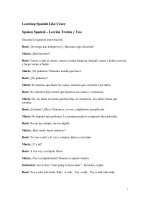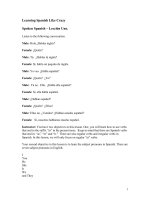learning spanish like crazy level 1
Bạn đang xem bản rút gọn của tài liệu. Xem và tải ngay bản đầy đủ của tài liệu tại đây (1.8 MB, 350 trang )
1
Learning Spanish Like Crazy
Spoken Spanish – Lección Uno.
Listen to the following conversation.
Male: Hola ¿Hablas inglés?
Female: ¿Quién?
Male: Tú. ¿Hablas tú inglés?
Female: Sí, hablo un poquito de inglés.
Male: Ya veo. ¿Habla español?
Female: ¿Quién? ¿Yo?
Male: Tú no. Ella. ¿Habla ella español?
Female: Sí, ella habla español.
Male: ¿Hablan español?
Female: ¿Quién? ¿Ellos?
Male: Ellos no. ¿Ustedes? ¿Hablan ustedes español?
Female: Sí, nosotros hablamos mucho español.
Instructor: You have two objectives in this lesson. One, you will learn how to use verbs
that end in the suffix “ar” in the present tense. Keep in mind that there are Spanish verbs
that end in: “ar,” “er” and “ir.” There are also regular verbs and irregular verbs in
Spanish. In this lesson, we will only focus on regular “ar” verbs.
Your second objective in this lesson is to learn the subject pronouns in Spanish. There are
seven subject pronouns in English:
I
You
He
She
It
We
and They
2
Instructor: The present tense is used in Spanish in several different ways. One, it can be
used to indicate an action in progress. For example:
Male: Yo hablo español ahora.
Instructor: Which means: “I am speaking Spanish now.”
Instructor: Two, the present tense can be used to show something that is done
continuously or ongoing. For example:
Male: Nosotros hablamos español todo el tiempo.
Instructor: Which means: “We speak Spanish all the time.”
Instructor: Three, unlike in English, in Spanish you can use the present tense for an
action that will be done in the future. For example:
Female: Esta noche, ella habla español en la clase.
Instructor: Which means: “Tonight, she will speak Spanish in the class.”
Instructor: Let’s begin by learning to use the verb “hablar” in the present tense.
“Hablar” means to speak.
Instructor: This is how to say the verb "to speak". Listen and repeat.
Female: Hablar. Hablar.
Instructor: Again, how do you say "to speak"?
Female: Hablar. Hablar.
Instructor: Did you make sure that you made your response before the recorded
speaker? And did you repeat after the recorded speaker? This is how to say “I speak.”
Listen and repeat.
Male: Hablo. Yo hablo.
Instructor: How do you say “I speak”?
Male: Hablo. Yo hablo.
Instructor: Can you guess which word means “I”?
Male: Yo. Yo.
3
Instructor: It is not always necessary to use the word “yo” or “I” in Spanish. “Yo” is
usually used for clarity or emphasis.
Instructor: Again: How do you say “I speak”?
Male: Hablo. Yo hablo.
Instructor: Make sure that you imitate the pronunciation of the recorded speaker. This
is how to say “you speak.” Listen and repeat.
Female: Hablas. Tú hablas.
Instructor: How do you say “you speak”?
Female: Hablas. Tú hablas.
Instructor: Can you guess which word means “You”?
Female: Tú. Tú.
Instructor: It is also not always necessary to use the word “tú” in Spanish. “Tú” is
usually used for clarity or emphasis.
Instructor: Again, how do you say “you speak”?
Male: Hablas. Tú hablas.
Instructor: Now say “I speak.”
Male: Hablo. Yo hablo.
Instructor: And how do you say “you speak”?
Male: Hablas. Tú hablas.
Instructor: There are also two ways to say “you” in Spanish. “Tú” is the familiar or
informal way of saying you. And “usted” is the polite or formal way of saying you.
If you are not sure when to use “tú” or “usted,” here’s a good rule of thumb. Use “tú”
when speaking to someone who you would normally address by their first name. And
use “usted” when speaking to someone who you would normally address by Mr. or Mrs.
Instructor: Considering that the objective of this course is to teach you informal, spoken
Spanish. Unless instructed to do otherwise, in this course you will use “tú,” the informal
word for “you.”
4
Instructor: This is how to say “he speaks” Listen and repeat.
Female: Habla. El habla.
Instructor: How do you say “he speaks”?
Male: Habla. -El habla.
Instructor: Can you guess which word means “He”?
Male: . El.
Instructor: It is also not always necessary to use the word “él” or “he.” “El” is usually
used for clarity or emphasis.
Instructor: Again: How do you say “he speaks”?
Female: Habla. El habla.
Instructor: Now say “I speak”
Male: Hablo. Yo hablo.
Instructor: And how do you say “you speak”?
Male: Hablas. Tú hablas.
Instructor: Now listen to how you’d say “she speaks.” Listen and repeat.
Female: Habla. Ella habla.
Instructor: How do you say “she speaks”?
Female: Habla. Ella habla.
Instructor: Can you guess which word means “she”?
Female: Ella. Ella.
Instructor: Did you notice that we used the word “habla” to mean “he speaks” and also
“she speaks?” That’s why Spanish speakers will sometimes use the words “él” and “ella”
for clarity or emphasis.
Instructor: Again, how do you say “she speaks”?
Female: Habla. Ella habla.
5
Instructor: Now say “I speak”
Male: Hablo. Yo hablo.
Instructor: And how do you say “you speak”?
Male: Hablas. Tú hablas.
Instructor: Now say “he speaks”
Male: Habla. El habla.
Instructor: And how do you say “she speaks”?
Female: Habla. Ella habla.
Instructor: Now listen to how you’d say “you speak” when using the formal or polite
form of the word “you.” Listen and repeat.
Female: Habla. Usted habla.
Instructor: How do you say “you speak” in the formal way?
Male: Habla. Usted habla.
Instructor: Can you guess which word means “you”?
Female: Usted. Usted.
Instructor: It is also not always necessary to use the word “usted.” Did you notice that
we used the word “habla” to mean “he speaks,” “she speaks,” and “you speak” when
using the “usted” form of you? That’s why Spanish speakers will sometimes use the
words “él,” “ella,” and “usted” for clarity or emphasis.
Instructor: Again, how do you say “you speak” when addressing someone who you’d
address by Mr. or Mrs.?
Female: Habla. Usted habla.
Instructor: Now say “I speak”
Male: Hablo. Yo hablo.
Instructor: When speaking to a friend, how do you say “you speak” in the informal
way?
6
Male: Hablas. Tú hablas.
Instructor: Now say “he speaks”
Male: Habla. Él habla.
Instructor: And how do you say “she speaks”?
Female: Habla. Ella habla.
Instructor: This is how to say “we speak.” Listen and repeat.
Female: Hablamos. Hablamos. Nosotros hablamos.
Instructor: How do you say “we speak”?
Male: Hablamos. Hablamos. Nosotros hablamos.
Instructor: Can you guess which word means “we”?
Female: Nosotros. Nosotros.
Instructor: Now listen how to say “they speak” when referring to a group of males or a
group that consists of both males and females. Listen and repeat.
Male: Hablan. Hablan. Ellos hablan.
Instructor: How do you say “they speak” when referring to a group of males or a group
that consists of both males and females.
Male: Hablan. Hablan. Ellos hablan.
Instructor: Can you guess which word means “they”?
Male: Ellos. Ellos.
Instructor: Now listen to how you’d say “they speak” when referring to a group that
only consists of females. Listen and repeat.
Female: Hablan. Ellas hablan.
Instructor: How do you say “they speak” when referring to a group of females?
Female: Hablan. Ellas hablan.
7
Instructor: Can you guess which word means “they”?
Female: Ellas. Ellas.
Instructor: Now listen how you’d say “all of you speak” when speaking to a group.
Listen and repeat.
Female: Hablan. Ustedes hablan.
Instructor: Are you making sure that you are imitating the pronunciation of the
recorded speaker? Again, how do you say “all of you speak” ?
Female: Hablan. Ustedes hablan.
Instructor: Can you guess which word means “all of you”?
Female: Ustedes. Ustedes.
Instructor: How do you say “all of you speak”?
Male: Hablan. Ustedes hablan.
Instructor: It is also not always necessary to use the word “ustedes.” Did you notice that
we used the word “hablan” to mean “they speak” as well as “all of you speak”? That’s
why Spanish speakers will sometimes use the words “ellos,” “ellas,” and “ustedes” for
clarity or emphasis.
Instructor: Now that you have learned how to make affirmative statements with the “ar”
verb “hablar.” Let’s learn how to make negative statements. This is how to say “I don’t
speak.” Listen and repeat.
Male: No hablo. Yo no hablo.
Instructor: Say: “I don’t speak.”
Female: No hablo. Yo no hablo.
Instructor: Try to say “You don’t speak” using the informal “you.”
Male: No hablas. Tú no hablas.
Instructor: Did you notice that in order to make a negative statement, you simply put
“no” before the verb? Now try to say “he doesn’t speak.”
Female: No habla. Él no habla.
8
Instructor: Again, how do you say “he doesn’t speak”?
Male: No habla. Él no habla.
Instructor: Now say “she doesn’t speak.”
Male: No habla. Ella no habla.
Instructor: Now say “You don’t speak” in the formal or polite way.
Female: No habla. Usted no habla.
Instructor: Do you remember how to say “we speak”?
Male: Hablamos. Nosotros hablamos.
Instructor: Now try to say “we don’t speak”
Female: No hablamos. Nosotros no hablamos.
Instructor: Again, say “we don’t speak”
Male: No hablamos. Nosotros no hablamos.
Instructor: Now say “they don’t speak” when referring to a group of males or a group of
both males and females.
Male: No hablan. Ellos no hablan.
Instructor: And how do you say “they don’t speak” when referring to a group of
females?
Female: No hablan. Ellas no hablan.
Instructor: And how do you say “all of you don’t speak”?
Male: No hablan. Ustedes no hablan.
Instructor: You have just learned how to use the “ar” verb “hablar” in the present tense.
However, you only learned how to make statements with the verb “hablar.” Now let’s
learn how to ask questions with the verb “hablar.” Listen to the following conversation.
Male: ¿Hablas inglés?
Female: ¿Quién?
9
Male: Tú. ¿Hablas tú inglés?
Female: Sí, yo hablo un poquito de inglés.
Male: ¿Habla español?
Female: ¿Quién? ¿Yo?
Male: Tú no. Ella. ¿Habla ella español?
Female: Sí, ella habla español.
Male: ¿Hablan español?
Female: ¿Quién? ¿Ellos?
Male: Ellos no. Ustedes. ¿Hablan ustedes español?
Female: Sí, nosotros hablamos mucho español.
Instructor: You just heard the word “quién” which means “who.” You also heard the
word “un poquito” which means “a little” or “a little bit.” Listen again. Escucha otra vez.
Male: ¿Hablas inglés?
Female: ¿Quién?
Male: Tú. ¿Hablas tú inglés?
Female: Sí, yo hablo un poquito de inglés.
Male: ¿Habla español?
Female: ¿Quién? ¿Yo?
Male: Tú no. Ella. ¿Habla ella español?
Female: Sí, ella habla español.
Male: ¿Hablan español?
Female: ¿Quién? ¿Ellos?
Male: Ellos no. Ustedes. ¿Hablan ustedes español?
Female: Sí, nosotros hablamos mucho español.
10
Instructor: When speaking to someone who you normally address by their first name,
this is the INFORMAL way to ask “do you speak Spanish” Listen and repeat.
Male: ¿Hablas español? Español. ¿Hablas tú español?
Instructor: Did you imitate the Spanish speaker’s rising intonation at the end of the
sentence?
Instructor: How do you ask or – ¿Cómo se pregunta? – “Do you speak Spanish?”
Female: ¿Hablas español? Español. ¿Hablas tú español?
Instructor: Be sure to check your pronunciation and imitate the Spanish speaker. How
do you say the word “Spanish”?
Female: Español. Español.
Instructor: Otra vez, cómo se dice Again, how do you say. –– “Spanish”?
Male: Español. Español.
Instructor: Cómo se pregunta? - How do you ask. –– “do you speak Spanish?”
Male: ¿Hablas español? ¿Hablas tú español?
Female: Sí, yo hablo español.
Instructor: She just said “yes, I speak Spanish” Listen and repeat the word for “yes”
Female: Sí, Sí.
Male: ¿Hablas tú español?
Instructor: Respond, “Yes, I speak Spanish.”
Female: Sí, hablo español. Sí, yo hablo español.
Instructor: Now ask him if he speaks Spanish.
Female: ¿Hablas español? ¿Hablas tú español?
Instructor: How does he respond, “No, I don’t speak Spanish”?
Male: No, no hablo español.
11
Instructor: Listen and repeat the word for “who.”
Female: Quién. Quién.
Instructor: Cómo se dice How do you say “who?”?
Female: ¿Quién? ¿Quién?
Instructor: Do you remember how to say “I”?
Female: Yo. Yo.
Male: ¿Hablas español?
Instructor: Try to respond, “who me”?
Female: ¿Quién yo? ¿Quién yo?
Instructor: ¿Cómo se pregunta? - How do you ask…? – – “who me?”?
Female: ¿Quién yo? ¿Quién yo?
Male: Sí, ¿hablas tú español?
Instructor: Now respond, “No, I don’t speak Spanish”
Female: No, no hablo español. No, yo no hablo español.
Male: ¿Habla español?
Instructor: Respond, “who me?”
Female: ¿Quién yo? ¿Quién yo?
Instructor: Listen and repeat the phrase “not you.”
Male: Tú no. Tú no.
Instructor: ¿Cómo se dice “not you”?
Female: Tú no. Tú no.
Male: ¿Habla español?
Instructor: Try to respond, “who him?”
12
Female: ¿Quién él? ¿Quién él?
Instructor: ¿Cómo se pregunta “who him?”
Male: ¿Quién él? ¿Quién él?
Instructor: How do you think he would respond “not him”?
Male: El no. El no.
Female: Entonces ¿quién?
Instructor: She just asked “then who?” Listen and repeat.
Female: Entonces ¿quién? Entonces. Entonces ¿quién?
Instructor: ¿Cómo se pregunta - How do you ask…? –– “then who?”
Female: Entonces ¿quién? Entonces ¿quién?
Instructor: Which word do you think means “then”?
Female: Entonces. Entonces.
Instructor: –¿Cómo se dice? Or how do you say “then”?
Male: Entonces. Entonces.
Male: ¿Hablan español?
Instructor: Try to ask "who them?"
Female: ¿Quién ellos? ¿Quién ellos?
Instructor: How does he respond "not them"?
Male: Ellos no. Ellos no.
Instructor: How do you say "all of you"?
Female: Ustedes. Ustedes.
Instructor: How do you ask "Do all of you speak Spanish?"
Male: ¿Hablan ustedes español?
13
Instructor: How do you reply "who us?"?
Female: ¿Quién nosotros? ¿Quién nosotros?
Male: Sí, ustedes. ¿Hablan ustedes español?
Instructor: How do you reply "Yes, we speak Spanish."
Female: Sí, hablamos español. Sí, nosotros hablamos español.
Instructor: This is how to say "to walk." Listen and repeat.
Female: Caminar. Caminar.
Instructor: ¿Cómo se dice "to walk"?
Male: Caminar. Caminar.
Instructor: Try to say “I walk”.
Female: Camino. Yo camino.
Instructor: How do you say "I walk"?
Male: Camino. Yo camino.
Male: ¿Caminas tú?
Instructor: How do you respond "Yes, I walk"?
Female: Sí, camino. Sí, yo camino.
Instructor: How do you ask "do you walk"?
Female: ¿Caminas? ¿Caminas tú?
Male: Sí, camino todos los días.
Instructor: He just said that he walks every day. Listen and repeat the phrase "every
day".
Male: Todos los días. Días. Los Días. Todos los días.
Instructor: ¿Cómo se dice “every day”
14
Female: Todos los días. Todos los días.
Instructor: Try to ask: “Does he walk?”
Female: ¿Camina? ¿Camina él?
Instructor: Respond, “Yes, he walks.”
Male: Sí, camina. Si, él camina.
Instructor: Now ask: Does he walk everyday?
Female: ¿Camina todos los días? ¿Camina él todos los días?
Instructor: Respond, “Yes, he walks everyday”
Male: Sí, camina todos los días. Sí, él camina todos los días.
This is the end of “lección uno.” If you were able to get 80% or more of the responses
correct in this lesson, then you are ready to move on to “lección dos.” If not, listen to this
lesson until you are able to get 80% or more of the responses correct.
1
Learning Spanish Like Crazy
Spoken Spanish – Lección Dos.
Listen to the following conversation:
Male: ¿Hablas inglés?
Female: Sí, hablo inglés porque practico todos los días.
Male: ¿Dónde?
Female: Practico inglés en la biblioteca.
Male: ¿En la bibioteca?
Female: Sí, en la bibloteca. ¿Estudias inglés?
Male: No, yo no estudio inglés.
Female: ¿Por qué no?
Male: Porque trabajo todos los días en el museo.
Female: mm ! ¿Manejas o caminas al museo?
Male: Yo camino al museo.
Instructor: Do you remember how to say the verb "to speak"?
Female: Hablar. Hablar.
Instructor: And how do you say “I speak Spanish”?
Male: Hablo español. Yo hablo español.
Instructor: How do you ask a friend “Do you speak Spanish?”
Female: ¿Hablas español? ¿Hablas tú español?
Instructor: Keep in mind that a more informal way to ask “Do you speak Spanish?”
would be “¿Tú hablas español? You can even ask ¿Usted habla español? As in English,
if you want to know if someone speaks English you can ask:
Do you speak English?
Or you can be more casual and ask: “You speak English?”
2
So that you are familiar with both methods of asking questions, throughout this course we
will use both methods.
Instructor: Listen and repeat the question “do you speak English?”
Female: ¿Hablas inglés? ¿Tú hablas inglés?
Instructor: If you are speaking to someone that you address by Sir or Mam, ask “do you
speak English?”
Female: ¿Habla inglés? ¿Usted habla inglés?
Instructor: Respond “Yes, I speak English.”
Male: Sí, hablo inglés. Sí, yo hablo inglés.
Instructor: Ask “Does he speak English?”
Female: ¿Habla inglés? ¿El habla inglés?
Instructor: Respond “No, he doesn’t speak English.”
Male: No, no habla inglés. No, él no habla inglés.
Instructor: Say “He speaks Spanish”
Male: Habla español. -El habla español.
Female: ¿Habla inglés?
Instructor: Ask “who?”
Male: ¿Quién?
Instructor: Ask “Who speaks English?”
Male: ¿Quién habla inglés? ¿Quién habla inglés?
Instructor: Ask again “Who speaks English?”
Male: ¿Quién habla inglés? ¿Quién habla inglés?
Instructor: Now ask “Does she speak English?”
Female: ¿Habla inglés? ¿Ella habla inglés?
3
Instructor: Pretend that you didn’t hear her, ask “who?”
Male: ¿Quién? ¿Quién?
Instructor: Ask “who him?”
Male: ¿Quién él? ¿Quién él?
Instructor: How does she say “Not him.”?
Female: El no. El no.
Instructor: Ask “Does she speak English?”
Female: ¿Habla inglés? ¿Ella habla inglés?
Instructor: Respond “No, she doesn’t speak English.”
Male: No, no habla inglés. No, ella no habla inglés.
Instructor: Say “She speaks Spanish.”
Male: Habla español. Ella habla español.
Instructor: Are you still making sure that you are making your response before the
recorded speaker? And are you still repeating after the recorded speaker, and making sure
that your pronunciation matches his?
Instructor: Do you remember how to say the verb "to walk"?
Female: Caminar. Caminar
Instructor: ¿Cómo se dice - How do you say…? - “I walk”?
Male: Camino. Yo camino.
Instructor: Do you remember how to say "everday"?
Female: Todos los días. Todos los días.
Instructor: Y ¿cómo se dice - And how do you say…? - “I walk every day”?
Male: Camino todos los días. Todos los días. Yo camino todos los días.
Instructor: When speaking to a friend, how do you ask “Do you walk”?
4
Female: ¿Caminas? ¿Tú caminas?
Instructor: Now ask “Do you walk everyday?”
Male: ¿Caminas todos los días? ¿Tú caminas todos los días?
Instructor: If you are speaking to someone that you address by Sir or Mam, how do you
ask “do you walk everyday?”
Female: ¿Camina todos los días? ¿Usted camina todos los días?
Male: Camino al museo.
Instructor: He just said that he walks to the museum. Listen and repeat.
Male: Camino al museo. Museo. Al museo. Yo camino al museo.
Instructor: Which word do you think means “museum”?
Female: Museo. Museo.
Instructor: ¿Cómo se dice “museum”?
Male: Museo. [] [El]Museo.
Instructor: How do you think you’d say “we walk”?
Male: Caminamos. Nosotros caminamos.
Instructor: How do you think you’d say “we walk to the museum”?
Female: Caminamos al museo. Al. Al museo. Nosotros caminamos al museo.
Instructor: ¿Cómo se dice: “to the museum”?
Male: Al museo. Al. Al museo.
Instructor: ¿Cómo se pregunta- How do you ask…? - “do all of you walk?"
Female: ¿Caminan? ¿Ustedes caminan?
Instructor: Respond “We walk”
Male: Caminamos. Nosotros caminamos.
5
Instructor: ¿Cómo se pregunta - How do you ask…? - "Do all of you walk to the
museum”?
Female: ¿Caminan al museo? ¿Ustedes caminan al museo?
Instructor: Respond “Yes, we walk to the museum”
Male: Sí, caminamos al museo. Sí, nosotros caminamos al museo.
Instructor: ¿Cómo se pregunta - How do you ask…? - "do they walk to the museum"?
Female: ¿Caminan al museo? ¿Ellos caminan al museo?
Instructor: Respond “Yes, they walk to the museum”
Male: Sí, caminan al museo. Sí, ellos caminan al museo.
Instructor: Again, ask. - "Do they walk to the museum"?
Female: ¿Caminan al museo?
Instructor: Ask “who them”?
Male: ¿Quién ellos? ¿Quién ellos?
Instructor: Say “not them”
Female: Ellos no. Ellos no.
Instructor: Referring to a group of females say “they”
Female: Ellas. Ellas
Instructor: Referring to a group of females, ask "Do they walk to the museum?"
Female: ¿Caminan al museo? ¿Ellas caminan al museo?.
Instructor: Respond “No, they do not walk to the museum”
Male: No, no caminan al museo. No, ellas no caminan al museo.
Male: Ellas manejan al museo.
Instructor: He just said that they drive to the museum.
Instructor: Listen and repeat the word “to drive.”
6
Male: Manejar. Manejar.
Instructor: Just like “hablar” and “caminar,” “manejar” is a regular “ar” verb.
Instructor: Try to say "I drive"
Male: Manejo. Yo manejo.
Instructor: ¿Cómo se dice "I drive"?
Female: Manejo. Yo manejo.
Instructor: Speaking to a friend, ¿cómo se pregunta “do you drive?”
Male: ¿Manejas? ¿Tú manejas?
Instructor: If you are speaking to someone that you address by Sir or Mam, how do you
ask “Do you drive?”
Female: ¿Maneja? ¿Usted maneja?
Instructor: Respond “Yes, I drive every day.”
Male: Sí, manejo todos los días. Sí, yo manejo todos los días.
Instructor: Try to ask “Does she drive?”
Female: ¿Maneja? ¿Ella maneja?
Instructor: Respond “No, she doesn’t drive.”
Male: No, no maneja. No, ella no maneja.
Instructor: ¿Cómo se dice “all of you”?
Female: Ustedes. Ustedes.
Instructor: Ask “Do all of you drive?”
Male: ¿Manejan? ¿Ustedes manejan?
Instructor: ¿Cómo se pregunta “Do all of you drive?”
Female: ¿Manejan? ¿Ustedes manejan?
7
Instructor: ¿Cómo se pregunta “Do all of you drive?”
Female: ¿Manejan? ¿Ustedes manejan?
Instructor: Try to respond “Yes, we drive”
Male: Sí, manejamos. Sí, nosotros manejamos.
Instructor: -¿Cómo se dice? How do you say “we drive”?
Female: Manejamos. Nosotros manejamos.
Male: Manejamos a la biblioteca todos los días.
Instructor: He just said that “we drive to the library everyday .” Listen and repeat the
word “library”.
Male: Biblioteca. Teca. Biblioteca. Biblioteca.
Instructor: ¿Cómo se dice “ library”?
Female: Biblioteca. Biblioteca.
Instructor: Now try to say “the library”
Male: La biblioteca. La biblioteca.
Instructor: This is how to say “to the library.” Listen and repeat
Male: A la biblioteca. A. A la biblioteca.
Instructor: ¿Cómo se dice “we drive to the library”?
Male: Manejamos a la biblioteca. A la biblioteca. Nosotros manejamos a la biblioteca.
Instructor: ¿Comó se pregunta “Do all of you drive?”?
Female: ¿Manejan? ¿Ustedes manejan?
Instructor: Respond “we drive to the library everyday.”
Male: Manejamos a la biblioteca todos los días. Nosotros manejamos a la biblioteca
todos los días.
Female: ¿Por qué?
8
Instructor: She just asked “why.” Listen and repeat the word “why.”
Female: ¿Por qué? ¿Qué? ¿Por qué?
Instructor: ¿Comó se pregunta “why?”?
Male: ¿Por qué? ¿Por qué?
Instructor: Ask “Why do all of you drive to the library everyday?”
Female: ¿Por qué manejan a la biblioteca todos los días? ¿Por qué? ¿Por qué ustedes
manejan a la biblioteca todos los días?
Instructor: Listen and repeat the word “because” in Spanish.
Male: Porque. Porque.
Instructor: Did you notice that the word for “why” and the word “because” are almost
the same in Spanish?
Instructor: ¿Cómo se dice “because”?
Female: Porque. Porque.
Instructor: Otra vez, pregunta- Ask again. “Why do all of you drive to the library
everyday?”
Female: ¿Por qué manejan a la biblioteca todos los días? ¿Por qué ustedes manejan a la
biblioteca todos los días?
Male: Porque trabajamos en la biblioteca.
Instructor: He just said “because we work in the library.”
Instructor: Listen and repeat the word “to work”
Male: Trabajar. Trabajar.
Instructor: Just like “hablar,” “caminar,” and “manejar,” “trabajar” is a regular “ar”
verb.
Instructor: Try to say "I work."
Male: Trabajo. Yo trabajo.
Instructor: ¿Cómo se dice "I work"?
9
Female: Trabajo. Yo trabajo.
Instructor: Speaking to a friend, try to ask “Do you work?”
Female: ¿Trabajas? ¿Tú trabajas?
Instructor: If you are speaking to someone that you address by Sir or Mam, how do you
ask “do you work?”
Female: ¿Trabaja? ¿Usted trabaja?
Instructor: Respond “Yes, I work”
Male: Sí, yo trabajo.
Instructor: Try to ask “Does she work?”
Female: ¿Trabaja? ¿Ella trabaja?
Male: No, ella nunca trabaja.
Instructor: He just said that she never works. Listen and repeat the word “never”
Male: Nunca. Nunca.
Instructor: ¿Cómo se dice “never”?
Female: Nunca. Nunca.
Instructor: Cómo se dice “I never work.”
Female: Nunca trabajo. Yo nunca trabajo.
Instructor: Now try to ask “Do all of you work?”
Male: ¿Trabajan? ¿Ustedes trabajan?
Instructor: ¿Cómo se pregunta “Do all of you work?”
Female: ¿Trabajan? ¿Ustedes trabajan?
Instructor: Try to respond “Yes, we work”
Male: Sí, trabajamos. Trabajamos. Sí, nosotros trabajamos.
10
Instructor: Say “We work every day”
Female: Trabajamos todos los días. Trabajamos. Nosotros trabajamos todos los días.
Instructor: Now say “they never work”
Male: Nunca trabajan. Ellos nunca trabajan.
Instructor: Ask “why?”
Female: ¿Por qué? ¿Por qué?
Instructor: Try to ask “why don’t they ever work?”
Female: ¿Por qué nunca trabajan? ¿Por qué ellos nunca trabajan?
Male: Porque ellos siempre estudian.
Instructor: He just said “because they are always studying.”
Instructor: Listen and repeat the word “to study”
Male: Estudiar. Estudiar.
Instructor: ¿Cómo se dice “to study”?
Female: Estudiar. Estudiar.
Instructor: Just like “hablar,” “caminar,” “manejar,” and “trabajar,” “estudiar” is also a
regular “ar” verb.
Instructor: Try to say "I study."
Female: Estudio. Yo estudio.
Instructor: ¿Cómo se dice "I study Spanish"?
Male: Estudio español. Yo estudio español.
Instructor: Try to ask “Do you study English?”
Female: ¿Estudias inglés? ¿Tú estudias inglés?
Instructor: Respond "No, I don’t study English."
Male: No, no estudio inglés. No, yo no estudio inglés.
11
Instructor: Say "I study Spanish."
Male: Estudio español. Yo estudio español.
Instructor: Try to ask “Does he study?”
Female: ¿Estudia? ¿Él estudia?
Instructor: Respond “He never studies.”
Male: Nunca estudia. Nunca. El nunca estudia.
Instructor: Ask “why not?”
Female: ¿Por qué no? ¿Por qué no?
Instructor: Reply “because he works everyday.”
Male: Porque trabaja todos los días. Trabaja. Porque él trabaja todos los días.
Instructor: Try to ask “does she study?”
Female: ¿Estudia? ¿Ella estudia?
Male: Ella siempre estudia.
Instructor: He just said that she always studies. Listen and repeat the word “always.”
Male: Siempre. Siempre
Instructor: ¿Cómo se dice “always”?
Female: Siempre. Siempre
Instructor: Say “I always study.”
Male: Siempre estudio. Yo siempre estudio.
Instructor: Now try to ask “Do all of you study?”
Female: ¿Estudian? ¿Ustedes estudian?
Instructor: Try to respond “Yes, we always study”
Male: Sí, siempre estudiamos. Estudiamos. Sí, nosotros siempre estudiamos.









